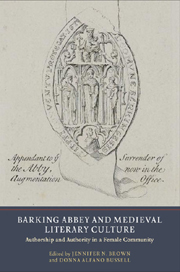Book contents
- Frontmatter
- Contents
- List of Contributors
- Acknowledgements
- List of Abbreviations
- Dedication
- Introduction: Barking's Lives, the Abbey and its Abbesses
- I BARKING ABBEY AND ITS ANGLO-SAXON CONTEXT
- 1 Barking's Monastic School, Late Seventh to Twelfth Century: History, Saint-Making and Literary Culture
- 2 The Saint-Maker and the Saint: Hildelith Creates Ethelburg
- 3 Goscelin of Saint-Bertin and the Translation Ceremony for Saints Ethelburg, Hildelith and Wulfhild
- 4 ‘The ladies have made me quite fat’: Authors and Patrons at Barking Abbey
- II BARKING ABBEY AND ITS ANGLO-NORMAN CONTEXT
- III BARKING ABBEY AND THE LATER MIDDLE AGES
- Afterword. Barking and the Historiography of Female Community
- Bibliography
- Index
- YORK MEDIEVAL PRESS: PUBLICATIONS
2 - The Saint-Maker and the Saint: Hildelith Creates Ethelburg
from I - BARKING ABBEY AND ITS ANGLO-SAXON CONTEXT
Published online by Cambridge University Press: 05 April 2013
- Frontmatter
- Contents
- List of Contributors
- Acknowledgements
- List of Abbreviations
- Dedication
- Introduction: Barking's Lives, the Abbey and its Abbesses
- I BARKING ABBEY AND ITS ANGLO-SAXON CONTEXT
- 1 Barking's Monastic School, Late Seventh to Twelfth Century: History, Saint-Making and Literary Culture
- 2 The Saint-Maker and the Saint: Hildelith Creates Ethelburg
- 3 Goscelin of Saint-Bertin and the Translation Ceremony for Saints Ethelburg, Hildelith and Wulfhild
- 4 ‘The ladies have made me quite fat’: Authors and Patrons at Barking Abbey
- II BARKING ABBEY AND ITS ANGLO-NORMAN CONTEXT
- III BARKING ABBEY AND THE LATER MIDDLE AGES
- Afterword. Barking and the Historiography of Female Community
- Bibliography
- Index
- YORK MEDIEVAL PRESS: PUBLICATIONS
Summary
According to Bede's Historia ecclesiastica, Erkenwald, bishop of London, founded Barking Abbey in the late seventh century for his sister Ethelburg at a place called in Berecingum. A supernatural sheet of light from heaven later showed Ethelburg where she should site a cemetery for the community's women (iv.7); this and other miraculous visions confirmed the holiness of both the abbey and Ethelburg herself. Ethelburg was succeeded as abbess, as Bede's account relates, by ‘a handmaid dedicated to God, by name Hildelith, who for many years, that is until extreme old age, governed the monastery very diligently, keeping regular discipline, and providing the things that appertained to general use’ (‘Successit autem Aedilburgi in officio abbatissae devota Deo famula, nomine Hildilid, multisque annis, id est, usque ad ultimam senectutem eidem monasterio strenuissime, in observantia disciplinae regularis, et in earum quae ad communes usus pertinent rerum providentia praefuit’).
Hildelith plays Martha to Ethelburg's Mary, as it were: she is the good provider, the maintainer of discipline, the diligent and responsible housekeeper. Most notably, ‘because of the narrowness of the place wherein the monastery was built’, Hildelith ‘thought it best to have the bones of the servants and handmaids of Christ, which were in that same place, taken up and all removed to the church of the blessed mother of God and there buried in one place’ (‘Cui cum propter angustiam loci in quo monasterium constructum est, placuisset ut ossa famulorum famularumque Christi quae ibidem fuerant tumulata, tollerentur, et transferrentur omnia in ecclesiam beatae Dei genetricis, unoque conderentur in loco’).
- Type
- Chapter
- Information
- Barking Abbey and Medieval Literary CultureAuthorship and Authority in a Female Community, pp. 56 - 72Publisher: Boydell & BrewerPrint publication year: 2012



